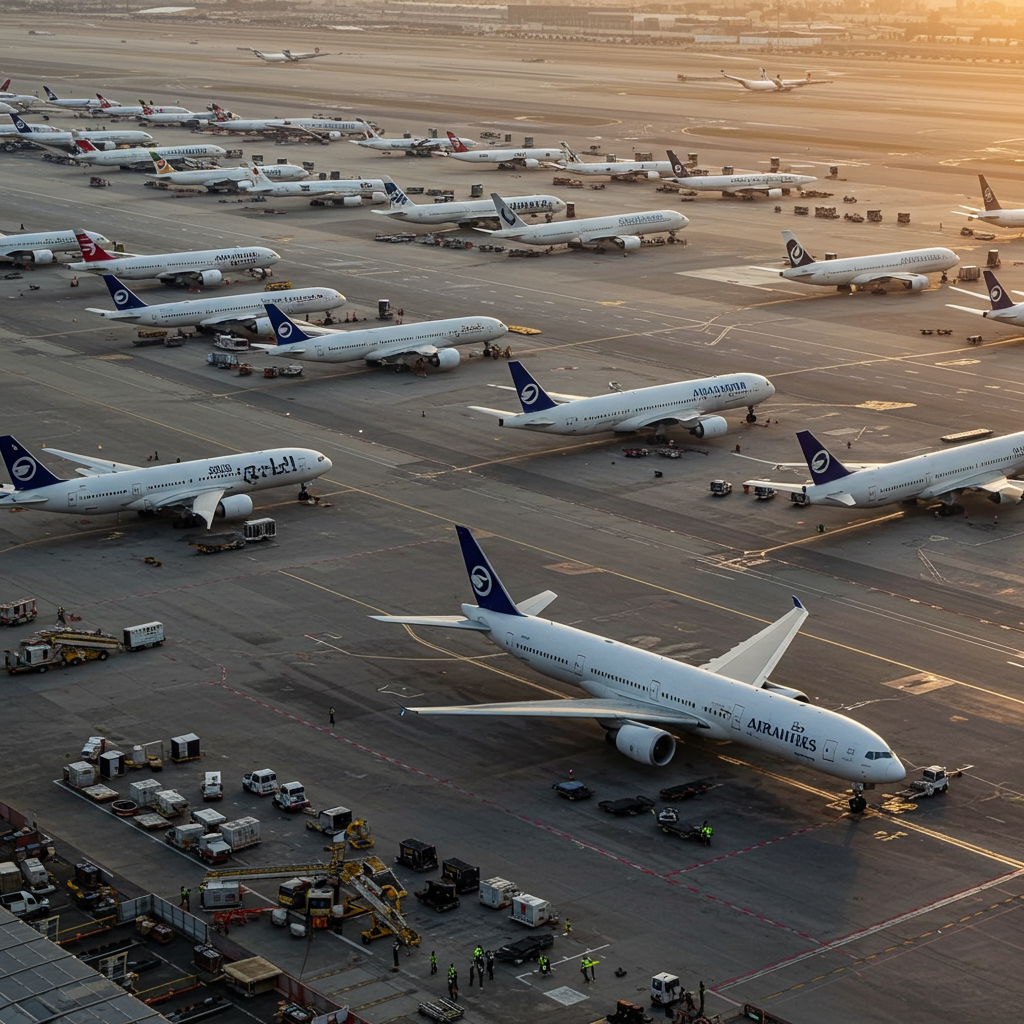escalating tensions involving Israel, Iran, and the US have triggered significant disruptions to air travel across the Middle East. Airlines have been compelled to cancel or reroute flights to and from the region, leaving thousands of travelers facing delays and uncertainty.
This instability struck one of the world’s most crucial aviation corridors, particularly impactful since routes over Russia and Ukraine became largely unavailable in 2022. The Middle East serves as a vital bridge for flights connecting Europe with Asia and Australia, with major hubs like Dubai and Doha handling nearly 400,000 travelers daily, plus another 80,000 through Abu Dhabi.
Temporary Airspace and Airport Closures
Amidst the heightened conflict, several countries in the region temporarily closed their airspace or halted airport operations. By late Monday, June 23rd, following earlier closures after Israel’s initial attacks on June 13th, countries including Qatar, Kuwait, Bahrain, the United Arab Emirates, and Iraq had closed their skies.
Qatar’s Hamad International Airport (Doha): A critical hub, operations were temporarily halted on Monday before reopening. This occurred after Iran reportedly fired missiles at a US base in Qatar, which Iran stated was retaliation for US strikes.
Dubai Airport (UAE): Flights were temporarily paused, with passengers advised to anticipate delays and cancellations.
Ben Gurion Airport (Tel Aviv): Israel’s main airport was briefly shut down, leading to its flag-carrier, El Al, suspending flights, though emergency operations later resumed.
Flight tracking data on Tuesday morning showed hundreds of cancellations globally, with Dubai International Airport reporting a notable number of affected flights.
Airlines Adjust Schedules Amid Risk
Over a dozen airlines have reacted by cancelling or significantly altering flight paths to avoid the volatile airspace. This includes a wide range of international carriers:
Air India: Announced a halt to all operations to the Middle East and rerouted or cancelled flights on affected routes, including services connecting to North America’s east coast and Europe. The airline is reportedly cutting about 15% of its international flights in the region.
European Carriers: Airlines like British Airways, Air France-KLM, Lufthansa Group (including Swiss, Austrian, ITA), and Finnair have cancelled routes or suspended services to destinations including Dubai, Doha, Riyadh, Tel Aviv, Beirut, Amman, Tehran, Baghdad, and Erbil, with some suspensions lasting well into July.
Asian Carriers: Singapore Airlines, Japan Airlines, and Philippine Airlines have cancelled flights to major hubs like Dubai, Doha, and Riyadh.
US/Canadian Carriers: American Airlines and United Airlines have suspended flights to Qatar and Dubai respectively. Air Canada halted its non-stop Toronto-Dubai route and is rerouting via European partners.
Gulf & Regional Carriers: Emirates, Qatar Airways, Etihad Airways, Flydubai, Gulf Air, SalamAir, EgyptAir, Royal Jordanian, Saudia, Oman Air, MEA, and Kuwait Airways are operating reduced schedules, suspending routes (like Emirates to Tehran, Baghdad, Basra until June 30; Etihad to Tel Aviv until July 15; Flydubai to Iran, Iraq, Israel, Syria until June 30), or avoiding specific overflights. El Al is primarily focused on rescue and repatriation.
Safety Concerns Drive Rerouting
The primary reason for these drastic measures is safety. Aviation safety bodies like Safe Airspace have issued alerts about the heightened risks posed by missile and drone activity in the region, particularly for commercial aircraft. Experts emphasize that states are responsible for ensuring their airspace is safe, commending temporary closures as the “absolutely right thing” to do.
The region has a history of civilian aircraft being caught in military conflict, including the accidental downing of an Iran Air flight in 1988 and a Ukrainian jet in 2020. Since 2001, globally, six commercial aircraft have been unintentionally shot down with three near-misses reported by aviation risk consultancies. The downing of Malaysia Airlines Flight 17 over Ukraine in 2014 remains a stark reminder of these dangers.
Operational and Financial Strain
Avoiding the conflict zones means commercial flights are now largely circumventing the airspace over Iran, Iraq, Lebanon, Syria, and Jordan. Roughly 1,400 flights daily typically traverse this key corridor between Asia and Europe.
These flights are now forced onto significantly longer detours, typically flying north over Turkey, the Caspian Sea, Georgia, and Afghanistan, or south over Saudi Arabia, the Red Sea, and the Arabian Sea.
These longer routes lead to:
Increased Costs: More fuel burn translates directly to higher operational expenses for airlines, exacerbated by surging jet fuel prices driven partly by the conflict.
Operational Inefficiency: Extended flight times impact aircraft availability and strain crew scheduling due to strict legal rest requirements.
- Airspace Congestion: Rerouting thousands of flights into narrower corridors, already handling traffic diverted from Russian/Ukrainian airspace, creates bottlenecks and potential delays across multiple continents.
- www.bbc.com
- www.aljazeera.com
- www.theannapurnaexpress.com
- www.euronews.com
- www.travelandtourworld.com
Impact on Travelers
For passengers, this translates into longer journey times, increased delays, confusion at airports, missed connections, and the possibility of rising ticket prices as airlines pass on higher costs. Many governments have advised against travel to parts of the region, potentially forcing travelers to cancel plans. Decisions on flying may need to be made on a “day-by-day basis.”
As an aviation consultant noted, disruption in air travel is fundamentally interconnected and can spread “almost like wildfire” across the network. While Gulf carriers are highly experienced in adapting to regional volatility, the current situation presents complex challenges, particularly coinciding with the peak summer travel season.
Travelers are strongly advised to continuously check flight statuses with their airline, monitor government travel advisories, and consider flexible booking options or travel insurance due to the evolving situation. The path ahead for air travel through the Middle East remains highly dependent on regional developments.



